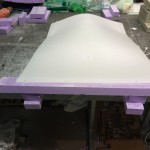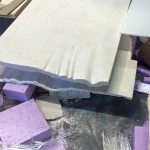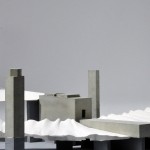The following text has been written by Aiden Conway. Besides the description of the project, Aiden explains how to use acrylic one in an architectural model.
The project was aimed at discovering an approach to work in the isolated landscapes of Mayo in the West of Ireland. To do this the nature and the man made were put at odds to one another creating a conflict which would hopefully provide a method of resolving the two. This resulted in a series interventions that appear at first as a haphazard collection of volumes in the landscape, but are in fact a direct reaction to it. Each intervention creates a moment of detachment during which and an urban moment is constructed and the landscape denied, before the landscape is then reintroduced via the core function of the intervention. These forms were derived both from the study of the city and its formal components and as a reaction to the landscape in order to obscure it, reductions of both.
In any case when it came to modelling each one, the interventions was heavy and massive and wanted to contrast that by representing the landscape in a soft and light manner, as somewhat of a thin datum.
Each site and its greater context was illustrated accurately at a scale of 1:25000 in machine milled mahogany models. Because of this I thought the 1:100 models could be more expressive.
Materials Required:
-Acrylic one Mix (consisting of the mineral powder and acrylic resin)
-Flexible Sheet of Fibre reinforcing
-3mm white Foam board
-30mm Foam board
The material Acrylic One was chosen to create this thin layer. It has visual properties similar to that of plaster but is much more durable and also workable after it has dried. The mould for each site was created via bending thing layers of foam and fixing them in the desired position. The openings into which the intervening volumes (cast in coloured concrete) were to be placed, were created by foam blocks. The entire formwork is then sprayed with an even coat of silicon spray to aid the casts removal from the formwork.
The Acrylic one which is a two-component material and consists of a mineral powder and a water based acrylic resin was then mixed at a ratio of two parts powder one part resin and applied to the surface of the foam formwork. It sets quickly and so needs to be applied rather rapidly. Its best to create enough of a mix to coat the surface in one pour so as to limit the possibility of two pours where the wet and dry don’t always bond correctly and can lead to discolouration. I chose to apply the mix with a spoon so as to use the underside of the spoon to spread it across the formwork.
Once the initial layer is applied evenly and at a minimum thickness of 3/4mm and before its is fully dried the layer of fibre reinforcing is applied( pre-cut and trimmed to fit the formwork but also to remain at distance of 25-30mm form the desired edge of the form work so as to avoid loose and exposed threads). This should be flat to the surface and pushed gently into the still wet mix. After this the second mix should be applied. While it is preferable to pour the second mix while the first has yet to dry it is not completely necessary. The mix is then left to fully dry for at least 18 hours.
The foam formwork was removed. At some points had bonded with the acrylic was removed with the back of a knife or an upturned chisel, to scrape away the foam but also to take a thin layer of the surface with it if needed. once the form work was removed the remaining foam was sanded to the desired smooth finish. The cloth like undulations at the edges was created by cutting the curves on the wire foam cutter -passing it through vertically- this was then glued to the formwork. The best results were achieved when the joints between the formwork and the curved blocks were as smooth as possible, but if not the workability of the acrylic one allows these joints to be smoothed out afterwards.
While I only had limited time to experiment with the material I think it has many potential applications and its limitations can be pushed much further than i had managed. I’d highly recommend it not only for its aesthetic values but also its workability after being poured, by which i mean the potential to alter its finish and also carve or work the surface.




